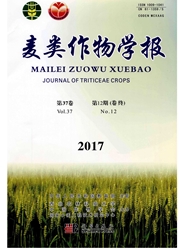

 中文摘要:
中文摘要:
为了探索大麦籽粒结构和淀粉粒与其用途的关系,利用扫描电子显微镜(SEM)和差示扫描量热分析仪(DSC)对啤酒大麦(港啤1号和扬农啤2号)与饲用大麦(扬饲麦1号)的籽粒结构和淀粉粒进行了比较研究。结果表明,3个品种表现相似的胚乳结构,但啤酒大麦的淀粉粒与蛋白质结合不紧密,饲用大麦的淀粉粒和蛋白质结合较紧密,且饲用大麦的蛋白质基质含量高于啤酒大麦。采用碱处理和差速沉淀法分离了籽粒胚乳大、中、小淀粉粒,虽然品种间淀粉粒的形态无明显差别,但大、中、小淀粉粒的大小和含量差异很大。DSC分析所得参数表明,大淀粉粒糊化时的起始温度(To)、峰值温度(Tp)和终结温度(n)高于相同品种的中、小淀粉粒,且糊化过程所需的热焓(△H)也较高。
 英文摘要:
英文摘要:
In order to study the relationships between barley Kernel structure, starch grauule, the kernel structure and starch granule of malt barley (Gangpi 1 and Yangnongpi 2) and feed barley (Yan- gsimai 1) were analyzed by scanning electron microscopy (SEM). Feed barley exhibited a high degree of starch-protein association,while malt barley indicated a low degree of starch-protein binding. Thecontent of proteinaceous matrix was higher in feed barley than that in malt barley. The large, medium and small starch granules were also isolated by the alkali method and differential sedimentation from the barley varieties. There was no detectable difference in the granule morphology between the feed and two malt barley varieties. However differences existed among varieties in size and content of large, medium and small starch granule. DSC thermal parameters showed that there was a dramaticdifference in shape of DSC curves among large, medium and small starch granules. Compared with medium and small starch granules, large starch granule had higher onset temperature (To), higher peak temperature (Tp), higher conclusion temperature (Tc), and higher gelatinization enthalpy (H).
 同期刊论文项目
同期刊论文项目
 同项目期刊论文
同项目期刊论文
 期刊信息
期刊信息
